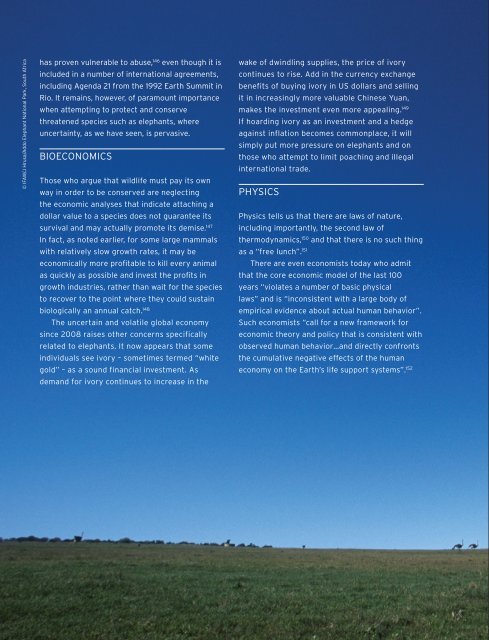ELEPHANTS & IVORY
ELEPHANTS & IVORY
ELEPHANTS & IVORY
You also want an ePaper? Increase the reach of your titles
YUMPU automatically turns print PDFs into web optimized ePapers that Google loves.
© IFAW/J Hrusa/Addo Elephant National Park, South Africa<br />
has proven vulnerable to abuse, 146 even though it is<br />
included in a number of international agreements,<br />
including Agenda 21 from the 1992 Earth Summit in<br />
Rio. It remains, however, of paramount importance<br />
when attempting to protect and conserve<br />
threatened species such as elephants, where<br />
uncertainty, as we have seen, is pervasive.<br />
BIOECONOMICS<br />
Those who argue that wildlife must pay its own<br />
way in order to be conserved are neglecting<br />
the economic analyses that indicate attaching a<br />
dollar value to a species does not guarantee its<br />
survival and may actually promote its demise. 147<br />
In fact, as noted earlier, for some large mammals<br />
with relatively slow growth rates, it may be<br />
economically more profitable to kill every animal<br />
as quickly as possible and invest the profits in<br />
growth industries, rather than wait for the species<br />
to recover to the point where they could sustain<br />
biologically an annual catch. 148<br />
The uncertain and volatile global economy<br />
since 2008 raises other concerns specifically<br />
related to elephants. It now appears that some<br />
individuals see ivory – sometimes termed “white<br />
gold” – as a sound financial investment. As<br />
demand for ivory continues to increase in the<br />
wake of dwindling supplies, the price of ivory<br />
continues to rise. Add in the currency exchange<br />
benefits of buying ivory in US dollars and selling<br />
it in increasingly more valuable Chinese Yuan,<br />
makes the investment even more appealing. 149<br />
If hoarding ivory as an investment and a hedge<br />
against inflation becomes commonplace, it will<br />
simply put more pressure on elephants and on<br />
those who attempt to limit poaching and illegal<br />
international trade.<br />
PHYSICS<br />
Physics tells us that there are laws of nature,<br />
including importantly, the second law of<br />
thermodynamics, 150 and that there is no such thing<br />
as a “free lunch”. 151<br />
There are even economists today who admit<br />
that the core economic model of the last 100<br />
years “violates a number of basic physical<br />
laws” and is “inconsistent with a large body of<br />
empirical evidence about actual human behavior”.<br />
Such economists “call for a new framework for<br />
economic theory and policy that is consistent with<br />
observed human behavior…and directly confronts<br />
the cumulative negative effects of the human<br />
economy on the Earth’s life support systems”. 152<br />
SOCIAL SCIENCES<br />
Sociologists, anthropologists, and philosophers,<br />
among others, tell us that humans value the<br />
Earth and its inhabitants in a variety of ways<br />
beyond the purely economic 153 and that, at some<br />
point, values other than money may actually<br />
determine human quality of life and happiness. 154<br />
At least one country, Bhutan, has actually<br />
abandoned the flawed and misleading metric of<br />
Gross Domestic Product (GDP) or Gross National<br />
Product, and replaced it with something it calls<br />
Gross National Happiness. 155<br />
While we’re back on the topic of economics,<br />
experience and reason tell us that economic<br />
activities, including job creation, poverty<br />
alleviation, and sustainable development,<br />
among other distractions, are human activities<br />
that occur within the environment. 156 Without a<br />
functioning environment, both society and the<br />
economy collapse.<br />
PHILOSOPHY<br />
The recognition of the continuum that exists<br />
between humans and other animals, including<br />
elephants, in terms of their common evolutionary<br />
legacy, shared genes, anatomy, physiology,<br />
intelligence and social psychology, has led to the<br />
argument that “there should be some continuum in<br />
moral standards”, 157 a view that seems logical but<br />
one that has yet to become generally accepted.<br />
Philosophy and ethics also reinforce the view<br />
mentioned earlier that living organisms and the<br />
nonliving components of the biosphere have<br />
values other than economic value. It is generally<br />
accepted, for example, that individual organisms<br />
and populations have intrinsic value, i.e. value<br />
beyond their utility to humans. 158<br />
WHERE TO FROM HERE?<br />
This concludes our cursory survey of some<br />
important things that a variety of disciplines<br />
teach us about the nature of elephants and the<br />
natural world. We use this information in the next<br />
chapter to explore how a consideration of all our<br />
knowledge and understanding would dramatically<br />
change our approach to the conservation of<br />
elephants now, and in the future.<br />
67


